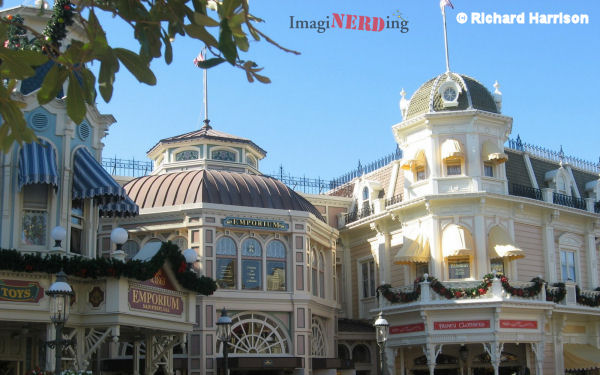As we are chatting about detail and facade design, here's a couple to discuss from Paris. They are not perfect, but have charm. We added a San Francisco feel to our East Center Street (renamed Market Street in DLP). The Victorian details are more eclectic and fanciful and very dimensional. We decided that they would be apartments or boarding houses to add a residential dimension to the street. The design needs to have story content and props to really feel real. The Signage shown here is from Beulah's Boarding House. (Beulah relates the the Disney film "Summer Magic" as it's a town in Maine). Some of the names have significance too, such as "Harmony Bob" running the nearby Barber Shop, "Dr. Sherwood" being the first person to hire Walt to draw picture of his horse, and "J. (Jack) Junkmeyer" was the first Editor of the Disneyland Newspaper back in 1955. Godey is known for a woman's fashion journal of the 1860's-70''s named "Godey's Lady's Book".
http://en.wikipedia.org/wiki/Godey's_Lady's_Book
Sound effects of "piano lessons" waft out the upstairs window as we hear practicing from time to time so the facade has life going on. Studying Piano and practice was a common back as homes had parlors, movies like "The Music Man" featured this.
Can't recall the significance if any of the other names, although we used period Disney movies as a source from time to time. There was a real "H.M. Sanders" that wrote about other metaphysical writings back in 1900, but that was not my suggestion, maybe someone in show writing tossed him in. The other detail we noticed at Disneyland that had gotten lost was the use of mailboxes. We tried to add them where appropriate to make the street feel like a real town. (Now I wish there was a crate of fake milk bottles on the porch!) The "No Tobacco" sign is an antique as it adds personality to the propriety of the house. In some places there are parked bicycles.
We also tried something new to Main Street which had historic precedent, doing awnings with solid trim and graphics on the edges or in the body. ICE CREAM is emblazoned on the edges of the awnings you see there and that was a new graphic design detail we began back in Paris. It busied things up, but added some character to the facades.
The point here is that facades are not just decorated walls to hide the stores,
they are the threads that make up the social fabric of the small town. Facades as much as anything tell our story in a subtle, implicit way. They contain more than Disney insider references, they exist to enhance the area's theme as a source of story, drawn from the sense of community that is Main Street.
They communicate in many ways beyond architecture the personality of those who live inside of them, otherwise they are just that, facades. Even if they are masks, they need to have expression and personality. Buildings are happy or sad, just like cars seem to have faces. Everything matters. The color communicates the taste and in some cases the gender of the inhabitants. The materials and textures communicate the period and even the locale as they are usually native to an area. Banks and other institutions were meant to say "trust" so they'd have Greek columns to say they have legacy and strength, the limestone or granite says they will be there forever and so your money is safe. Our City Hall was done in that tradition as well. What "they" (our citizens) leave behind on the porch or erect on a sign betrays a lifestyle or personality, and we sense all of that. If that dimension is missing or random, we sense that at some level too. I venture to guess the strong reaction to these facades at HKDL and WDW is not just visual, it's also a gut reaction to something deeper as they may not respond that well to the "town" aspects of Main Street.
Or do they? Since we see the same "Emporium" sign on all of the WDW buildings in that picture, maybe there is a sort of truth here that's actually part of the story. The big box Emporium has expanded to close down all the small Mom and Pop businesses, taking over the entire block. That's American! Is the small town is now a mall town? It's funny that the 1955 MSUSA story was always about a "small town in transition from Gas to Electric and from Horse and buggy to Horseless Carriage". Of course, these developments would lead to one outcome, growth. Progress is another dilemma that faces any small town. Has Main Street given way to Walt-Mart?

